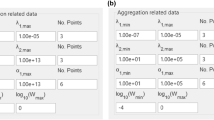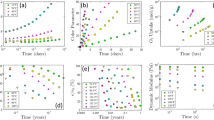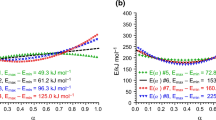Abstract
The accurate calculation of reaction rates from experimental data is crucial for understanding and characterizing chemical processes. However, the presence of noise in experimental data can introduce errors in rate calculations. In this study, we introduced a novel approach that utilizes the Legendre series expansion method to directly derive smooth reaction rates from noisy experimental data, eliminating the need for numerical differentiation methods. This approach proves to be highly effective in handling noisy thermogravimetric analysis (TGA) data obtained from the thermal decomposition of specific polymers. We demonstrated the robustness and reliability of this method and provided Gnu Octave codes as a free alternative to MATLAB, making the implementation more accessible. Furthermore, the smooth reaction rates obtained were used to evaluate the activation energy using the Friedman isoconversional method. The results showed excellent agreement with those obtained using the Vyazovkin integral method. Additionally, the proposed method can be applied to obtain smooth derivative thermogravimetric (DTG) curves using noisy TGA data set.
Similar content being viewed by others
Data availibility
No datasets were generated or analysed during the current study.
References
N. Sbirrazzuoli, Simulations for evaluation of kinetic methods in differential scanning calorimetry. Part 2. Effect of additional noise on single-peak methods. Thermochim. Acta 273, 169–184 (1996). https://doi.org/10.1016/0040-6031(95)02611-8
G. Várhegyi, F. Till, Computer processing of thermogravimetric-mass spectrometric and high pressure thermogravimetric data. Part 1. Smoothing and differentiation. Thermochim. Acta 329(2), 141–145 (1999). https://doi.org/10.1016/S0040-6031(99)00041-6
H. Chen, N. Liu, L. Shu, R. Zong, Smoothing and differentiation of thermogravimetric data of biomass materials. J. Thermal Anal. Calorim. 78(3), 1029–1041 (2004). https://doi.org/10.1007/s10973-004-0468-6
R. Cao, S. Naya, Nonlinear regression checking via local polynomial smoothing with applications to thermogravimetric analysis. J. Chemom. 23(6), 275–282 (2009). https://doi.org/10.1002/cem.1227
X. Zhang, W. Jong, F. Preto, Estimating kinetic parameters in tga using b-spline smoothing and the friedman method. Biomass Bioenergy 33(10), 1435–1441 (2009). https://doi.org/10.1016/j.biombioe.2009.06.009
G. Berčič, The universality of friedman’s isoconversional analysis results in a model-less prediction of thermodegradation profiles. Thermochim. Acta 650, 1–7 (2017). https://doi.org/10.1016/j.tca.2017.01.011
G. Berčič, P. D**ović, A. Pintar, Procedure for generation of catalyst-free pe-tg profiles and its consequence on calculated activation energies. J. Thermal Anal. Calorim. 128, 443–456 (2017). https://doi.org/10.1007/s10973-016-5872-1
T. Onsree, N. Tippayawong, Application of gaussian smoothing technique in evaluation of biomass pyrolysis kinetics in macro-tga. Energy Proced. 138, 778–783 (2017). https://doi.org/10.1016/j.egypro.2017.10.059
M.C. Bruns, I.T. Leventon, Automated fitting of thermogravimetric analysis data. Fire Mater. 45(3), 406–414 (2021). https://doi.org/10.1002/fam.2849
S. Vyazovkin, A.K. Burnham, J.M. Criado, L.A. Pérez-Maqueda, C. Popescu, N. Sbirrazzuoli, ICTAC kinetics committee recommendations for performing kinetic computations on thermal analysis data. Thermochim. Acta 520(1–2), 1–19 (2011). https://doi.org/10.1016/j.tca.2011.03.034
A. Aghili, A.H. Shabani, Application of the orthogonal collocation method in evaluating the rate of reactions using thermogravimetric analysis data. Thermochim. Acta 8, 179698 (2024). https://doi.org/10.1016/j.tca.2024.179698
G. Bao, D. Schild, Fast and accurate fitting and filtering of noisy exponentials in Legendre space. PLoS ONE 9(3), 90500 (2014). https://doi.org/10.1371/journal.pone.0090500
N. Shklov, Simpson’s rule for unequally spaced ordinates. Am. Math. Monthly 67(10), 1022–1023 (1960). https://doi.org/10.2307/2309244
N. Kovvali, Theory and Applications of Gaussian Quadrature Methods (Springer Nature, New York, 2011)
A. Aghili, V. Arabli, A.H. Shabani, Rational approximations of the arrhenius and general temperature integrals, expansion of the incomplete gamma function. Chem. Eng. Commun. 211, 844–858 (2024). https://doi.org/10.1080/00986445.2023.2300791
S. Vyazovkin, A.K. Burnham, L. Favergeon, N. Koga, E. Moukhina, L.A. Pérez-Maqueda, N. Sbirrazzuoli, ICTAC kinetics committee recommendations for analysis of multi-step kinetics. Thermochim. Acta 689, 178597 (2020). https://doi.org/10.1016/j.tca.2020.178597
S. Vyazovkin, D. Achilias, X. Fernandez-Francos, A. Galukhin, N. Sbirrazzuoli, ICTAC kinetics committee recommendations for analysis of thermal polymerization kinetics. Thermochim. Acta 714, 179243 (2022). https://doi.org/10.1016/j.tca.2022.179243
H.L. Friedman, Kinetics of thermal degradation of char-forming plastics from thermogravimetry. Application to a phenolic plastic. J. Polym. Sci. Part C 6(1), 183–195 (1964). https://doi.org/10.1002/polc.5070060121
S. Vyazovkin, Modification of the integral Isoconversional method to account for variation in the activation energy. J. Comput. Chem. 22(2), 178–183 (2001).
Funding
This research did not receive any specific grant from funding agencies in the public, commercial, or not-for-profit sectors.
Author information
Authors and Affiliations
Contributions
Alireza Aghili: Conceptualization, Methodology, Software, Writing—Original Draft Preparation, Writing—Review & Editing, Data Curation, Investigation, Supervision, Project Administration Amir Hossein Shabani: Software, Visualization.
Corresponding author
Ethics declarations
Conflict of interest
The authors declare that they have no known competing financial interests or personal relationships that could have appeared to influence the work reported in this paper.
Additional information
Publisher's Note
Springer Nature remains neutral with regard to jurisdictional claims in published maps and institutional affiliations.
Supplementary Information
Below is the link to the electronic supplementary material.
Appendices
Appendix A
1.1 Differential isoconversional method
To investigate the correlation between activation energy (E), pre-exponential factor (A), and the conversion degree (\(\alpha \)), denoted as \(E_{\alpha }\) and \(A_{\alpha }\) respectively, isoconversional methods are utilized. One notable approach is the model-free differential isoconversional procedure introduced by Friedman [18]. This technique is applicable to any arbitrary temperature program:
where the subscript i indicates the ordinal number assigned to a specific experiment, while \(T_{\alpha ,i}\) corresponds to the temperature at which the desired extent of conversion is achieved in that experiment. The application of the Friedman method can be broadened to encompass non-isothermal conditions, where multiple experiments are conducted at various constant heating rates denoted as \(\beta _{i}\). In such scenarios, the equation associated with this methodology is expressed as follows:
Therefore, the slope of plotting \(\ln \left( {d\alpha }/{dt} \right) _{\alpha ,i}\) or \(\ln \left[\beta _{i}\left( {d\alpha }/{dT} \right) _{\alpha ,i} \right]\) against \( {1/T}_{\alpha ,i} \) will be \(\left( - E_{\alpha }/R \right) \) and the activation energy \(E_{\alpha }\) can be obtained from the slope.
1.1.1 Incremental integral isoconversional method
The incremental integral isoconversional methods are based on the assumption that the kinetic parameters, \(A_{\alpha }\) and \(E_{\alpha }\), remain constant within a specified conversion range \({\Delta }\alpha \). This range is defined by lower bound \(\alpha _{-}\) and upper bound \(\alpha _{+}\), with \({\Delta }\alpha = \alpha _{+} - \alpha _{-}\). In our study, we set \(\alpha _{+} = \left( \alpha + {\Delta }\alpha /2 \right) \) and \(\alpha _{-} = \left( \alpha - {\Delta }\alpha /2\right) \).
Vyazovkin [19] has proposed an advanced isoconversional method that introduces an incremental approach. By minimizing the function \(\Phi (E_{\alpha })\) within the interval \([\alpha _{-}, \alpha _{+}]\), the activation energy \(E_{\alpha }\) value can be determined:
where the function \(J\left[ E_{\alpha },T\left( t_{\alpha }\right) \right] \) is:
Similarly, for a series of runs performed at different constant heating rates, the function \(\Phi (E_{\alpha })\) has the following form:
where the function \(I\left( E_{\alpha },T_{\alpha }\right) \) is:
Appendix B
1.1 Legendre polynomials
The Legendre polynomial \(P_{n} (x)\) is a solution to the Legendre differential equation:
The first few Legendre polynomials and their first derivatives are listed in Table 2. The Legendre polynomials and their first derivatives obey the recurrence relations. This study employed the following relations:
Rights and permissions
Springer Nature or its licensor (e.g. a society or other partner) holds exclusive rights to this article under a publishing agreement with the author(s) or other rightsholder(s); author self-archiving of the accepted manuscript version of this article is solely governed by the terms of such publishing agreement and applicable law.
About this article
Cite this article
Aghili, A., Shabani, A.H. Evaluation of smooth reaction rate of noisy experimental data using Legendre series expansion. J Math Chem 62, 1521–1536 (2024). https://doi.org/10.1007/s10910-024-01618-4
Received:
Accepted:
Published:
Issue Date:
DOI: https://doi.org/10.1007/s10910-024-01618-4




